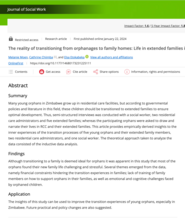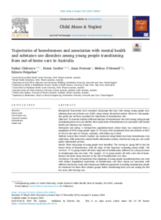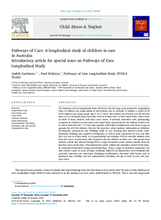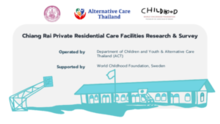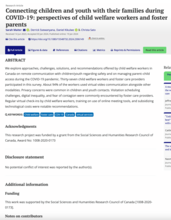Displaying 161 - 170 of 14145
Este Conjunto de Herramientas está compuesto de las herramientas enumeradas a continuación, que pueden ser leídas de manera independiente o conjunta.
Many young orphans in Zimbabwe grow up in residential care facilities, but according to governmental policies and literature in this field, these children should be transitioned to extended families to ensure optimal development. This article provides empirically derived insights to the inner experiences of the transition processes of five young orphans and their extended family members, two residential care administrators, and one social worker.
The aim of this study was to examine whether different subtypes of homelessness risk exist among young people transitioning from care in Australia and whether these trajectories of homelessness are associated with mental health and substance use disorders.
This longitudinal study uses a causal effect model to examine, through decomposition, the relationship between care environment and HIV risk factors in orphaned and separated adolescents and youths (OSAY) in Uasin Gishu County, Kenya; considering resilience, social, peer, or family support, volunteering, or having one’s material needs met as potential mediators. The authors analysed survey responses from 1105 OSAY age 10–26 living in Charitable Children’s Institutions (CCI) (orphanages) and family-based care settings (FBS).
Many children in Vietnam who lost their parents to COVID aren't getting by as support from the outside world is unsustainable.
Norwegian youth in out-of-home care move three times as frequently as their peers. Such placement instability is linked to negative outcomes in terms of social attachment, well-being, educational achievements, health, and future opportunities. Norway implemented a new child welfare service reform in 2022 that increased the municipalities responsibilities for out-of-home care. This study evaluates how the implemented measures affect the number of moves within out-of-home care in Trøndelag county. Norway.
The Pathways of Care Longitudinal Study (POCLS) is the first large-scale prospective longitudinal study of children and young people in out-of-home care in Australia. It includes a cohort of all 4126 children and young people (age 0 to 17 years) who entered out-of-home care for the first time over an 18-month period from May 2010 to October 2011 in New South Wales, with a focus on 2828 of these children with final court orders.
This is a summary of every private residential care facility in the Chiang Rai Province of Thailand, including institutional care homes, children’s homes, and residential schools. This summary provides an extensive and useful data set for those interested in the reform of private children's homes.
This is a summary of children's homes in the Chiang Mai Province of Thailand over the last 1.5 years. The research team visited a total of 371 private children's homes. This summary provides an extensive and useful data set for those interested in the reform of private children's homes.
The authors explore approaches, challenges, solutions, and recommendations offered by child welfare workers in Canada on remote communication with children/youth regarding safety and on managing parent–child access during the COVID-19 pandemic.


